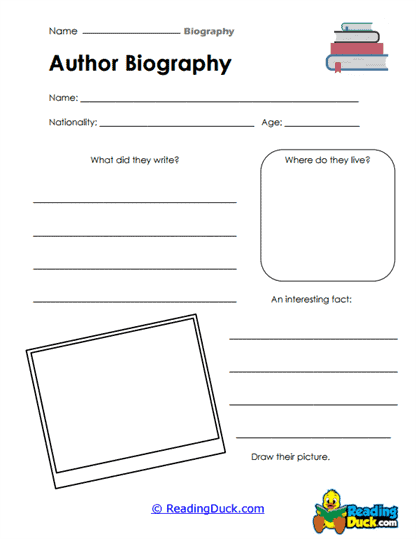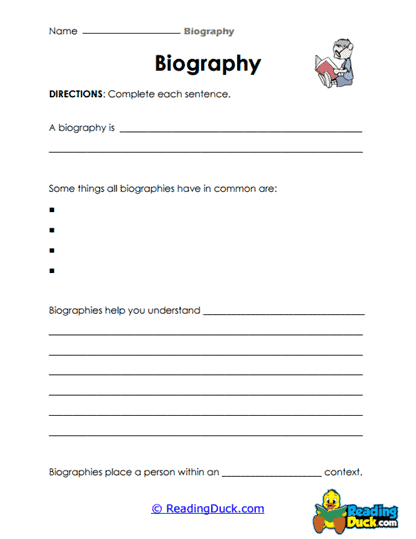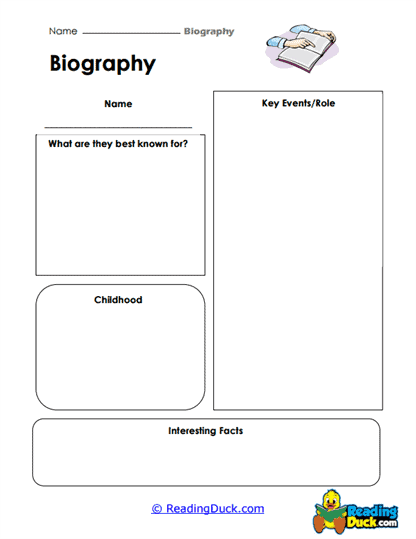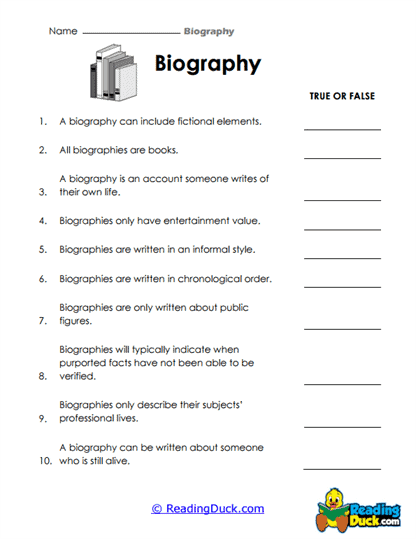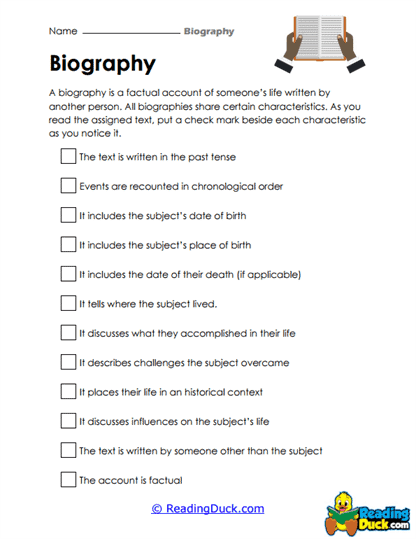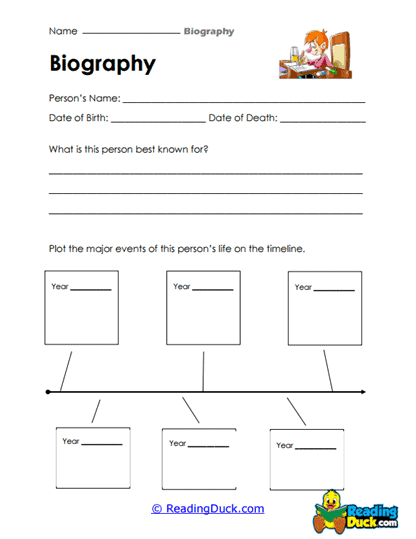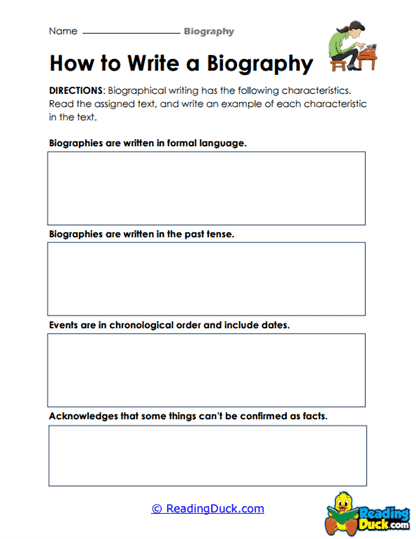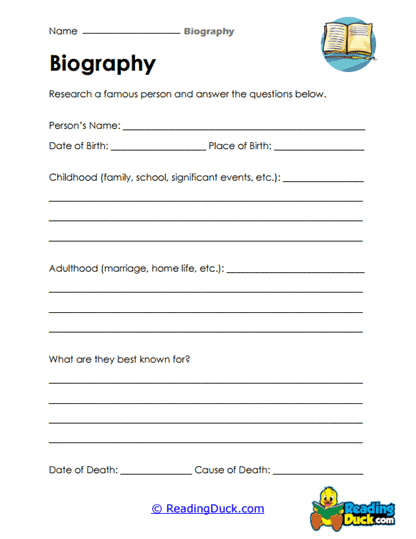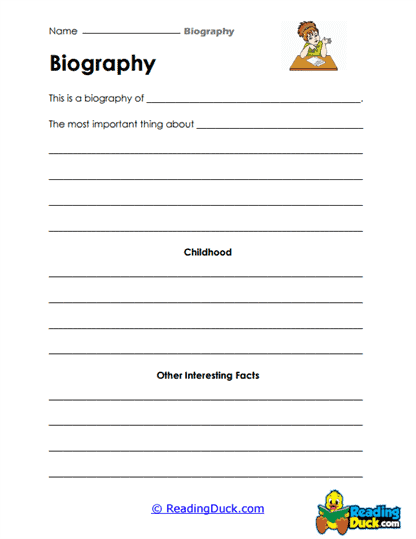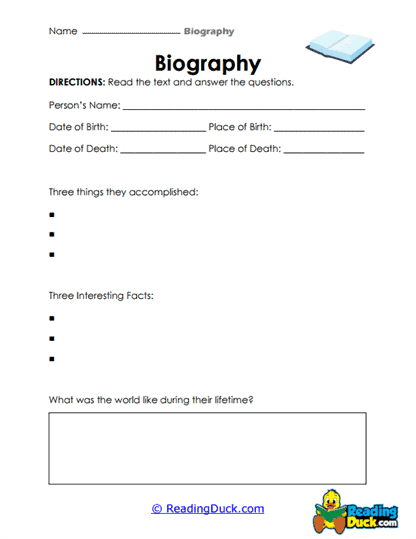Biography Writing Worksheets
About Our Biography Writing Worksheets
Our Biography Writing Worksheets collection is designed to help students master the biography genre while enhancing their writing skills. These worksheets guide students through the process of writing a biography, from researching to organizing and crafting a compelling narrative. Each worksheet is designed with clear, step-by-step instructions, allowing learners to build their skills progressively, starting with foundational tasks and advancing to more complex writing activities.
This collection is suitable for a variety of educational settings, including classrooms, homeschooling, and independent practice. Available in PDF format, these worksheets are easy to view, download, and print, offering flexibility for teachers and parents. Each worksheet includes a downloadable answer key to assist educators and parents in tracking student progress effectively.
Understanding Biography Writing
Biography writing involves telling the life story of a real person based on factual information. It covers key elements such as:
- Key life events: Important milestones like birth, childhood, education, career achievements, and major life changes.
- Challenges and accomplishments: The obstacles the individual faced and how they overcame them.
- Legacy: The lasting impact the person has had on society or their field of expertise.
Unlike fictional stories, biographies aim to inform and inspire readers by offering a detailed look into someone’s life. They provide insight into a person's character, motivations, and significant life events, giving readers a deeper understanding of historical or contemporary figures.
When teaching biography writing, educators focus on several foundational aspects:
- Research: Students learn how to gather factual information from credible sources, including books, websites, interviews, and videos. For example, a student writing a biography on Marie Curie would need to research her groundbreaking work in radioactivity, her challenges as a female scientist in the early 20th century, and the impact her discoveries had on science and medicine.
- Organization: A well-written biography follows a clear structure, typically starting with the subject's early life, moving through important events chronologically, and concluding with a reflection on the person’s legacy. For instance, a biography of Steve Jobs would trace his early interest in technology, his founding of Apple, his struggles and successes within the company, and his influence on modern tech culture.
- Engagement: Biography writing requires students to go beyond listing facts; they must make the subject come to life by including vivid descriptions and meaningful details. Rather than writing, "Nelson Mandela was imprisoned for many years," a student might write, "Nelson Mandela endured 27 years of imprisonment on Robben Island, where his determination to fight for equality only grew stronger with each passing year."
Here are examples of popular biographies that can inspire students:
- "The Diary of a Young Girl" by Anne Frank
This is a firsthand account of Anne Frank’s life in hiding during World War II. While it is technically a diary, many consider it a form of autobiography, providing deep insight into Anne’s experiences and the historical period she lived in. Students can learn how personal accounts can form the foundation of powerful biographical writing. - "Steve Jobs" by Walter Isaacson
Isaacson’s biography of Steve Jobs offers a detailed look at the life of the co-founder of Apple. Through interviews and research, Isaacson crafts a compelling story about Jobs’ creativity, leadership, and personal challenges. This biography teaches students how to balance factual research with engaging storytelling. - "Alexander Hamilton" by Ron Chernow
This extensive biography of one of America’s Founding Fathers inspired the Broadway musical Hamilton. Chernow’s work dives into Hamilton’s life as an immigrant who rose to prominence in U.S. history. The book provides a strong example of how biographies can bring history to life and make complex figures relatable. - "Long Walk to Freedom" by Nelson Mandela
Mandela’s autobiography provides an inspiring account of his fight against apartheid in South Africa. Students can learn from Mandela’s storytelling, which includes detailed descriptions of his early life, his political awakening, and his years of imprisonment. - "Frida: A Biography of Frida Kahlo" by Hayden Herrera
This biography explores the life of the iconic Mexican artist, Frida Kahlo, focusing on her personal struggles and creative achievements. Herrera captures both the artist’s flamboyant public image and her private pain. Students can see how a biography can delve into a subject’s emotional and artistic life.
Through these examples, students can see how a well-crafted biography combines research with narrative to create a compelling and informative piece of writing. Biographies offer more than just a chronological list of events; they explore the human experience, motivations, and emotional depth of the subject, helping readers connect with the person on a deeper level.
By guiding students through the biography writing process using our worksheets, they will develop essential skills such as:
- Analyzing sources to gather relevant facts.
- Structuring information into a coherent, logical sequence.
- Using descriptive language to create a vivid portrayal of the subject’s life.
Through these worksheets, students will not only improve their writing skills but also develop critical thinking and research skills, which are valuable for academic success and beyond.
Scaffolding for Progression and Mastery
Our worksheets follow a scaffolded approach, supporting students from basic to more complex tasks. This structure ensures that learners can gradually build confidence and proficiency.
Here’s how the scaffolding works:
- Basic Concepts: Students start by learning to identify the essential components of a biography, such as name, birthdate, and key achievements.
- Timelines: As students progress, they learn to organize life events chronologically, helping them understand the importance of structuring information clearly.
- Paragraph Development: The worksheets teach students how to write engaging topic sentences and smooth transitions between paragraphs.
- Synthesis: Advanced worksheets guide students in combining facts and research into a cohesive narrative, focusing on both accuracy and storytelling.
For example, a beginner worksheet might ask students to list three important facts about their chosen subject, while an advanced worksheet might require them to draft a complete biography with an introduction, body, and conclusion.
Supporting Teachers and Parents in Assessing Progress
To help teachers and parents evaluate student performance, each worksheet includes a downloadable answer key. This resource allows for quick and accurate assessment of student work, whether the task is identifying key biography elements or drafting a complete life story.
Tips for evaluating student work:
- Accuracy: Ensure students have included factual information in their biographies, such as correct dates and names.
- Organization: Check that students have presented information in a logical sequence, typically starting with the subject’s early life and moving through significant events.
- Writing Quality: Look for clear sentences, effective use of descriptive language, and smooth transitions between paragraphs.
In addition to the answer key, teachers and parents can encourage self-reflection, asking students to assess their own work for strengths and areas for improvement.
Adapting for ESL Learners and Students Needing Extra Support
Our worksheets are designed to be adaptable for ESL learners and students who need additional writing support. These learners might face challenges with organizing information or understanding complex vocabulary, but our worksheets provide clear, scaffolded instructions to help them succeed.
Strategies for supporting diverse learners:
- Simplified Tasks: Start ESL students with simpler worksheets that focus on basic biography elements like identifying dates, names, and events.
- Language Support: Provide vocabulary lists or sentence starters to help students formulate sentences and express their ideas more clearly.
- Step-by-Step Guidance: Break down complex tasks into smaller, manageable steps. For example, guide students through organizing a biography by helping them list key life events before asking them to write full paragraphs.
By offering tailored support, these worksheets enable all students to engage with the material and improve their writing skills at their own pace.
Adapting the Worksheets for Different Skill Levels and Classroom Settings
One of the key advantages of our biography writing worksheets is their flexibility. They can be easily adapted to fit different skill levels and classroom environments. Here’s how:
- For Beginners: Teachers can use the worksheets to introduce the basics of biography writing, providing guided practice and additional examples to support understanding.
- For Advanced Learners: Students can be challenged to write biographies about lesser-known figures or to conduct independent research, developing more sophisticated writing and research skills.
- Flexible Use: The worksheets can be integrated into lesson plans as the primary resource for a biography writing unit or as supplemental material for reinforcing specific skills.
- Hands-On Engagement: These worksheets offer practical, hands-on activities that can be used in small group work, independent assignments, or even as part of oral presentations or multimedia projects.
Whether used as the central component of a lesson or to supplement classroom activities, these worksheets help students engage with biography writing in a meaningful and interactive way.
Engaging Students with Practical, Hands-On Learning
Our Biography Writing Worksheets offer students a practical, engaging way to develop both their writing skills and their understanding of real-world people and events. By progressing through scaffolded tasks, students not only learn how to write biographies but also gain valuable research, organization, and critical thinking skills. Whether for classroom use, homeschooling, or independent practice, these worksheets provide students with the tools they need to succeed in biography writing.
With flexible formats, clear instructions, and support for all learners, these worksheets empower educators, parents, and students to approach biography writing with confidence and creativity.
